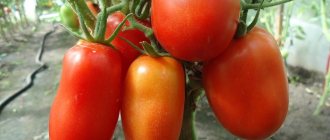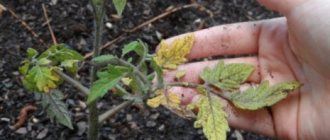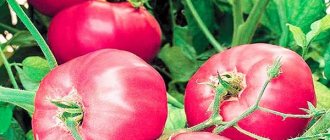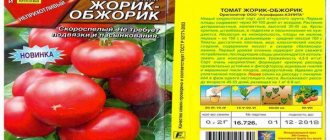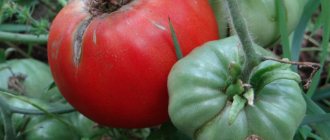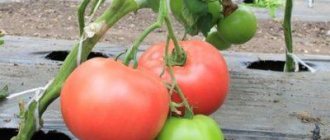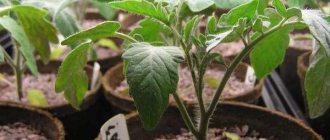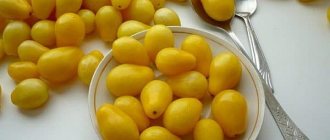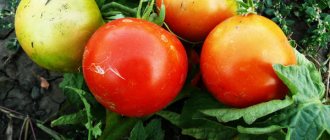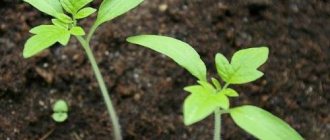Hybrid for closed ground, film and glazed greenhouses. Selection "Research Institute of Vegetable Growing of Protected Soil" and agro. Tomato Vladimir F1 was registered in the State Register in 2001. Recommended for growing in light zones 3 and 5.
| Height | Landing location | Ripening time | Fruit color | Fruit size | Origin | Fruit shape |
| Tall | Greenhouse | Mid-early | Reds | Average | Hybrid | Flat-round |
Description and characteristics of the variety
The plant is of an indeterminate type, with an average ripening period of 105-115 days. The stem is strong, with short internodes, and quickly grows green mass. Tomato leaves, medium size, dark green. There is an articulation on the stalk. The bushes are tied to a support as they grow.
The skin of tomatoes is not susceptible to cracking during ripening and heat treatment.
The inflorescence is simple, produces 5-8 ovaries, and does not break under the weight of the fruit. The first brush is laid after the 10th sheet, the subsequent ones - after 3 sheets. The fruits are flat-round, medium in size, weighing 110-130 grams. The ribbing at the top of the tomato is weakly expressed. The skin is durable, bright red, uniform in color. The internal structure is 4-6 chambered, the flesh is dense, juicy, the taste is balanced.
Description of the main characteristics
The bushes grow quite tall, have medium density foliage with a dark green color. Pruning of side shoots and cutting off the lower foliage is mandatory. It is recommended to form bushes with no more than 1 – 2 stems. The first ovary, as a rule, appears above the 9th leaf, and each subsequent one appears after another 3 leaves.
The fruits themselves, at the stage of full biological ripening, are distinguished by their rich red color, flat round shape and average weight of about 100 - 140 g. If the necessary conditions for successful cultivation are met, you can get tomatoes weighing 160 - 180 g. The pulp is quite juicy and dense at the same time, with a balanced taste . The peel is quite thin, but does not allow the fruit to crack, including during heat treatment. Thanks to this, grown tomatoes are successfully used not only fresh or for making sauces, but also as the main ingredient in canning for the winter.
The demand for the hybrid among experienced gardeners can also be determined by its increased productivity, since from one cultivated bush you can harvest about 4.5 - 5 kg of fully ripened, tasty tomatoes. Each cluster often produces 4–6 fruits, which is why it is recommended to carefully tie them up. Plants patiently tolerate changes in air temperature, but react extremely painfully to both prolonged drought and an excess of water in the soil, accompanied by the formation of puddles and stagnation that do not allow the necessary oxygen to reach the roots.
Advantages and disadvantages
Pros:
- Fruiting from mid-July until frost.
- Genetic resistance to tobacco mosaic virus, fusarium, cladosporiosis.
- Easily tolerates short-term cold snaps and drought.
- Good yield.
- Suitable for small-volume cultivation.
- Yields up to 99% commercial quality tomatoes.
- Tomatoes are aligned in shape and weight.
- It can be stored and transported for a long time.
- Suitable for farming.
- Universal use of the harvested crop.
Minuses:
- Not intended for open ground.
- Seeds must be purchased every year.
- It is necessary to regularly thin out the green mass and remove shoots.
Prevention of possible diseases
Experienced gardeners recommend using fungicides or insecticides, which are toxic chemicals, to prevent damage from insect pests. The preparation of the solution must be carried out in careful compliance with all requirements and ratios. At the same time, you definitely need to think about your own protection in advance.
It is more advisable to spray bushes very early in the morning or in the evening, after sunset. Thanks to this trick, the sprayed substance will have time to be absorbed into the tops of the plants themselves before it evaporates under the rays of the hot sun. It is extremely important to know that such work should be carried out no later than 14 - 18 days before the planned harvest of the first harvests.
In order to minimize the risk of fusarium or any other fungal and microbial infections located and multiplying in the soil, it is worth sifting mustard or turnip seeds even during the autumn cultivation of the soil. During the onset of spring warmth, the seedlings are carefully mowed and be sure to be dug up. As the practice of experienced gardeners shows, the risk of new infections is reduced by up to three times.
Features of cultivation and storage
Tomatoes are tall, spreading, and do not like thickening or excessive watering. The root system is vertical, and during drought it receives water from the lower layers of the soil. The bushes quickly grow foliage and produce a lot of extra shoots. If fertilizers are applied excessively, they begin to “fatten”. The fruits and stems should not come into contact with the ground, so the tomatoes are tied up.
Lodging of bushes leads to a lack of lighting and accumulation of moisture on the leaf blades, which provokes the appearance of diseases.
The main difference between a hybrid is its ability to be stored for a long time. Ripe tomatoes do not lose their taste for 1.5-2 months when kept at home.
Receiving seedlings in your personal yard
It is recommended to buy seeds from a trusted manufacturer. They are disinfected with a weak solution of potassium permanganate and then treated with growth stimulants. It is recommended to plant the seeds to a depth of 10-15 mm so that there is a distance of 2-3 cm between them. When the first shoots appear after 6 days, they are watered with a small amount of warm water, and the boxes with the tomato are transferred to a bright place. After 2-3 leaves appear on the seedlings, the plants are picked.
Young bushes should be transplanted to permanent soil when they are 60 days old. To do this, prepare the soil on the site. The beds are loosened, and organic fertilizers are added to the soil. For 1 sq. m. beds, it is recommended to plant no more than 3-4 bushes. Plants must be planted in holes strictly vertically so that their roots can reach the groundwater layer. This planting saves the hybrid from death during drought.
Before planting bushes in the beds, it is recommended to treat the soil with potassium permanganate to destroy bacteria and fungi living in the soil.
Rules for growing the variety
What technology is it advisable to use to grow tomatoes of the Vladimir variety?
- Initially, seed germination is carried out. To obtain friendly shoots, you will need to germinate the seeds. It is advisable to plant the seeds in small boxes and then cover them with a bag. It is extremely important to closely monitor humidity and temperature levels.
- Tomato seedlings are grown in plastic cups.
- Tomato seedlings are transplanted only into heated soil. It is advisable to hold this event in about 2 months. It is advisable to plant tomato seedlings only in high-quality nutrient soil, in which sand, humus and soil will be mixed. It is advisable to plant tomato seedlings about 2 centimeters deep. Sowing activities are carried out taking into account standard agricultural technology, as the further development of tomato bushes also depends on this.
- In the future, you will need to take care of high-quality and proper care of tomato seedlings of the Vladimir variety. Comprehensive care is considered mandatory. For example, it is assumed that it is necessary to take care of weeding the soil, watering, and applying fertilizers. Gardeners know that in order to get a good harvest, it is desirable to maintain temperature conditions, provide optimal lighting with average light brightness, regularly use a moderate amount of warm, settled water, weed the soil, carry out prevention against parasites and diseases, and apply fertilizers to the soil three or four times.
Successful cultivation of Vladimir variety tomatoes in Russia is possible subject to standard agricultural practices and careful monitoring of the condition of the vegetable crop.
Description of the tomato variety Vladimir F1, its characteristics and cultivation
Tomatoes are considered one of the most popular vegetable crops intended for growing in the garden. Tomato Vladimir F1 is characterized by high yield and is suitable for cultivation in any type of soil.
Characteristics of the tomato variety Vladimir
The variety Vladimir F1 belongs to the first generation hybrids. The tomato is a mid-early indeterminate hybrid for cultivation in any soil. The ripening time for vegetables after planting seeds in the soil is 100–105 days.
The adult plant is small in size, with medium foliage. It is necessary to tie it to a vertical support and remove side shoots. The leaves are dark green in color and have a shape characteristic of all varieties of tomatoes. Inflorescence of simple type. The first inflorescence begins to form under the 9th leaf. Subsequent ones - every 3 leaves. You can get the maximum yield if you form the bush into 2 main stems.
The variety is grown mainly in the southern regions. For planting in central, and especially northern latitudes, in most cases it is desirable to use a greenhouse. Advantages include resistance to tobacco mosaic, fusarium wilt and powdery mildew.
Description of tomato fruits Vladimir
Tomatoes of the Vladimir variety are large-fruited varieties with a bright red tint of skin and pulp. The shape of the fruit is round. Sometimes tomatoes grow irregularly shaped.
The skin is dense and durable. Thanks to this, ripe fruits are suitable for whole pickling. During the canning process, vegetables do not crack and the pulp remains dense. Ripe fruits are used to prepare various pickles, for example, lecho, sauces, ketchups or tomato juices. Tomatoes are also used to prepare vegetable salads.
Advantages and disadvantages of growing
The tomato hybrid Vladimir F1 has no serious shortcomings that affect productivity.
Advantages of the hybrid Vladimir:
- High yield throughout the entire fruiting period.
- Rapid emergence of seedlings.
- The taste of ripe vegetables.
- Universal use in cooking.
- Thick skin.
- Resistant to most tomato diseases.
- It is possible to cultivate seedlings in open and closed ground.
- Harvested vegetables can withstand long-term transportation and are suitable for sale.
Caring for the hybrid is minimal. Particular attention is paid to watering and fertilizing during the crop growing season. The beds need to be watered rarely. If it rains often, then watering should be abandoned. Once a week, before watering, the soil is weeded and all weeds are removed. It is not necessary to weed adult bushes.
To increase productivity, the beds are watered several times a season with mineral and organic fertilizers. Nitrogen, phosphorus and potassium are used as fertilizing. Suitable organic fertilizers include manure, chicken manure, mullein and wood ash. Depending on the condition of the bushes, the amount of fertilizing applied is increased or decreased.
Reviews about tomato Vladimir
Reviews about the sport of tomato Vladimir from summer residents.
“The best tomato that grew on the site. Vegetables began to ripen at the end of July. The fruits are large and taste sweet. They go well in salads and for meals. Bush care is minimal. The bushes were not watered all summer. They only applied fertilizers for yield. It is necessary to tie up the bushes due to the severity of the fruits. The branches are breaking."
Konstantin, 65 years old:
“I ordered the seeds on the Internet. The bag contained a small amount of seeds. Shoots appeared quickly. The seedlings grew well and after transplanting they quickly took to their new location. Mature bushes are tall and leafy. Tomatoes on each branch are formed in clusters. Ripe vegetables have a pleasant, sweetish taste. The Vladimir tomato is undemanding, but the yield remains high. The first harvest began in August.”
Reviews
Marina:
“Tomatoes of the Vladimir variety are successfully grown by Russian gardeners. Of course, growing tomatoes will require taking into account certain principles of agricultural technology, on which the condition of the tomatoes depends. In any case, tomatoes will delight you with an attractive presentation, optimal structure, and impeccable taste. The work of gardeners will be appreciated. Every season I am convinced that Vladimir tomatoes are ideal for growing.”
Valeria:
“I have been growing tomatoes of the Vladimir variety for several years in a row. This variety always pleases me with a decent harvest. In addition, it is possible to obtain tasty and nutritious tomatoes. The most important thing is to follow the basic rules of agricultural technology.”
Tomato Vladimir: characteristics of the variety, cultivation features, photo
Recently, the popularity of Vladimir tomatoes has been growing rapidly. Hybrid tomatoes have an optimal yield, although they can be grown in greenhouses and open ground. With proper agricultural technology, you can harvest up to 5 kilograms per plant, which is a fairly good indicator.
Tomatoes of the Vladimir variety are among the most popular in Russia. This hybrid tomato variety is suitable for growing in greenhouses and open ground. The most important thing for every gardener is to take into account the basic standards of agricultural technology.
Description and characteristics of the variety
Vladimir is a hybrid variety of mid-season tomatoes. It usually takes 107-115 days from germination to the start of ripening, so it is possible to significantly save time when receiving the first tasty tomatoes.
The Vladimir variety is distinguished by the following features:
- average growth of tomato bushes and the obligatory presence of a garter to the support;
- medium amount of dark green leaves;
- the first inflorescence is laid above the 9th leaf, subsequent ones - every 3 leaves;
- The best yield is achieved when the plant is formed into 2 stems.
When planning to grow tomatoes of the Vladimir variety, the following differences can be noted:
- flat-round shape;
- smooth glossy skin;
- red color of ripe tomatoes;
- weight is 100-140 grams, but sometimes the fruits reach a weight of 180 grams;
- fleshy texture;
- increased resistance to cracking.
Advantages and disadvantages of the variety
Tomato Vladimir is included in the State Register of the Russian Federation. In the last few years, the popularity of the hybrid variety in question has only increased.
The main advantages of the hybrid tomato variety Vladimir:
- optimal level of yield, and it is assumed that correct agricultural practices can be followed to guarantee a good harvest;
- obtaining large fruits of a pleasant presentation, thanks to which all the efforts of gardeners will certainly be justified;
- pleasant taste characteristics that determine the versatility of using grown tomatoes;
- suitability for long-term storage, but it is advisable to adhere to optimal conditions;
- resistance to parasites and diseases, making the chances of successfully growing tomatoes truly high.
Successful cultivation of hybrid tomatoes of the Vladimir variety becomes possible for gardeners who have different experience. There are practically no disadvantages, so you can count on getting a good and high-quality harvest of hybrid mid-season tomatoes.
